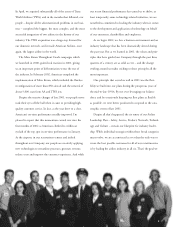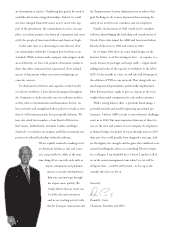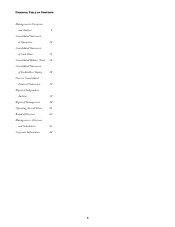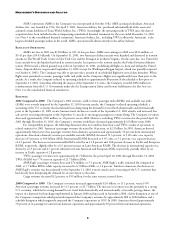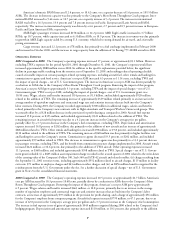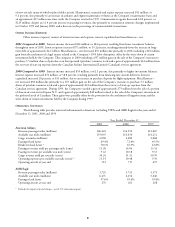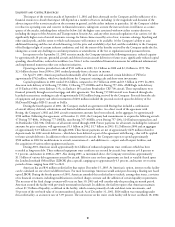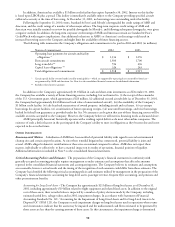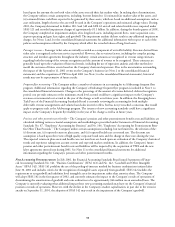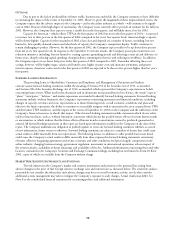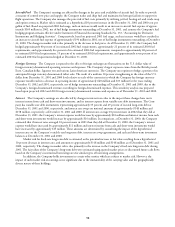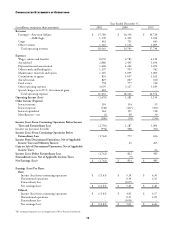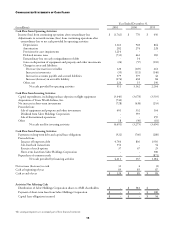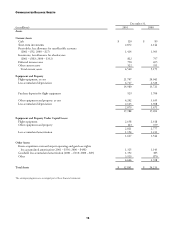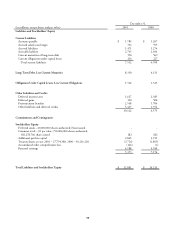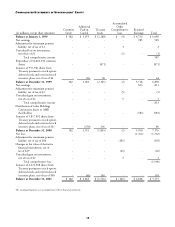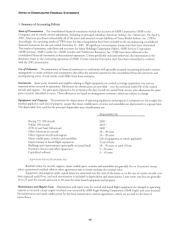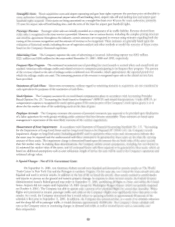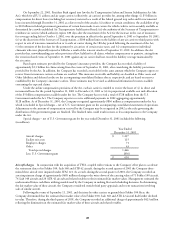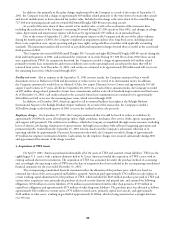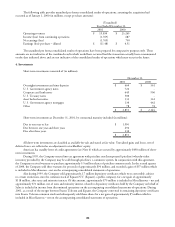American Airlines 2001 Annual Report Download - page 15
Download and view the complete annual report
Please find page 15 of the 2001 American Airlines annual report below. You can navigate through the pages in the report by either clicking on the pages listed below, or by using the keyword search tool below to find specific information within the annual report.13
Aircraft Fuel The Company’s earnings are affected by changes in the price and availability of aircraft fuel. In order to provide
a measure of control over price and supply, the Company trades and ships fuel and maintains fuel storage facilities to support its
flight operations. The Company also manages the price risk of fuel costs primarily by utilizing jet fuel, heating oil, and crude swap
and option contracts. Market risk is estimated as a hypothetical 10 percent increase in the December 31, 2001 and 2000 cost per
gallon of fuel. Based on projected 2002 fuel usage, such an increase would result in an increase to aircraft fuel expense of approx-
imately $169 million in 2002, net of fuel hedge instruments outstanding at December 31, 2001, and assumes the Company’s fuel
hedging program remains effective under Statement of Financial Accounting Standards No. 133, “Accounting for Derivative
Instruments and Hedging Activities”. Comparatively, based on projected 2001 fuel usage, such an increase would have resulted in
an increase to aircraft fuel expense of approximately $194 million in 2001, net of fuel hedge instruments outstanding at December
31, 2000. The change in market risk is due primarily to the decrease in fuel prices. As of December 31, 2001, the Company had
hedged approximately 40 percent of its estimated 2002 fuel requirements, approximately 21 percent of its estimated 2003 fuel
requirements, and approximately five percent of its estimated 2004 fuel requirements, compared to approximately 40 percent of
its estimated 2001 fuel requirements, 15 percent of its estimated 2002 fuel requirements, and approximately seven percent of its
estimated 2003 fuel requirements hedged at December 31, 2000.
Foreign Currency The Company is exposed to the effect of foreign exchange rate fluctuations on the U.S. dollar value of
foreign currency-denominated operating revenues and expenses. The Company’s largest exposure comes from the British pound,
Euro, Canadian dollar, Japanese yen and various Latin American currencies. The Company uses options to hedge a portion of its
anticipated foreign currency-denominated ticket sales. The result of a uniform 10 percent strengthening in the value of the U.S.
dollar from December 31, 2001 and 2000 levels relative to each of the currencies in which the Company has foreign currency
exposure would result in a decrease in operating income of approximately $40 million and $33 million for the years ending
December 31, 2002 and 2001, respectively, net of hedge instruments outstanding at December 31, 2001 and 2000, due to the
Company’s foreign-denominated revenues exceeding its foreign-denominated expenses. This sensitivity analysis was prepared
based upon projected 2002 and 2001 foreign currency-denominated revenues and expenses as of December 31, 2001 and 2000.
Interest The Company’s earnings are also affected by changes in interest rates due to the impact those changes have on its
interest income from cash and short-term investments, and its interest expense from variable-rate debt instruments. The Com-
pany has variable-rate debt instruments representing approximately 35 percent and 29 percent of its total long-term debt at
December 31, 2001 and 2000, respectively, and interest rate swaps on notional amounts of approximately $148 million and
$158 million, respectively, at December 31, 2001 and 2000. If interest rates average 10 percent more in 2002 than they did at
December 31, 2001, the Company’s interest expense would increase by approximately $10 million and interest income from cash
and short-term investments would increase by approximately $16 million. In comparison, at December 31, 2000, the Company
estimated that if interest rates averaged 10 percent more in 2001 than they did at December 31, 2000, the Company’s interest
expense would have increased by approximately $11 million and interest income from cash and short-term investments would
have increased by approximately $15 million. These amounts are determined by considering the impact of the hypothetical
interest rates on the Company’s variable-rate long-term debt, interest rate swap agreements, and cash and short-term investment
balances at December 31, 2001 and 2000.
Market risk for fixed-rate long-term debt is estimated as the potential increase in fair value resulting from a hypothetical
10 percent decrease in interest rates, and amounts to approximately $318 million and $148 million as of December 31, 2001 and
2000, respectively. The change in market risk is due primarily to the increase in the Company’s fixed-rate long-term debt during
2001. The fair values of the Company’s long-term debt were estimated using quoted market prices or discounted future cash flows
based on the Company’s incremental borrowing rates for similar types of borrowing arrangements.
In addition, the Company holds investments in certain other entities which are subject to market risk. However, the
impact of such market risk on earnings is not significant due to the immateriality of the carrying value and the geographically
diverse nature of these holdings.


